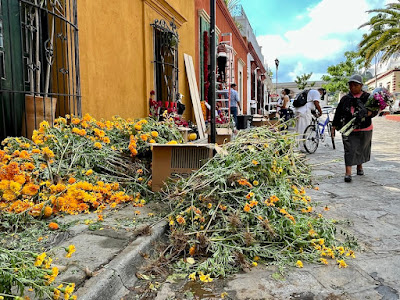PART 2 OF 5 PARTS
DIA DE MUERTOS
When I walk into the airport terminal, signs of Oaxaca’s early preparations for Día de Muertos are already evident. Even the narrow corridor from the arrival gate to Mexican customs and immigration is lined with art depicting one aspect or another of the occasion.
As I get settled in la Casa Conzatti and check out the hotel’s immediate surroundings, vendors are already selling bunches of golden cempasuchitl (marigolds) and fuchsia cresta de gallo (cock’s comb), the two flowers considered staples in decorating for the holiday.
Many families and some shops, including my hotel, are starting to build their altars, the often-multi-tiered displays of flowers, food and drink, and religious symbols thought to encourage and welcome home departed loved ones.
As the week unfolds and the radius of my exploring widens, I see more and more altars going up, from a simple four-foot circle of marigold petals and a couple of photos on the floor to seven-level extravaganzas designed, as one person explained, to represent the seven stages of a soul’s journey to a state of eternal rest.
In front of some shops what looks like truckloads of flowers get dropped on the sidewalk. Soon, the shops will be festooned in them, peopled with life-size or even gigantic catrina skeleton figures, and their façades even painted with special Día de Muertos murals.
The catrinas are sometimes arranged in real-life settings, like sitting on a bench reading a newspaper or making out with a partner. One huge one—about three stories tall—goes up overnight to loom over the Alcalá, the central historic district’s all-pedestrian street.
As the pivotal days of the celebration, November first and second, approach, the big Santo Domingo Church is putting the finishing touches on its massive outdoor altar. With seven levels and two large marigold arches, the thing extends at least 50 feet wide.
Even our school, Becari Manuel Bravo, builds an altar. I help trim the bushels of cempasuchitl, while teachers and other students pitch in to build the framework and arrange the other, non-floral elements: skeletons, candles, a Virgin of Guadalupe figure, Pan de Muertos—a special Day-of-the-Dead bread—fruit, and even bottles of Coke and mezcal.
I and a couple of other students have brought photos of deceased loved ones—in my case, my parents—to put on the finished altar. I think Mom and Dad would be pleased. Especially Dad, who would have loved to take his yen for learning Spanish this far.
By mid-week, it looks like about
a quarter of the people I see are
skeletons or zombies.
The atmosphere in the central city seems to be building to some kind of crescendo. I wander across what look to be spontaneous parades, with people walking and dancing, some of them animating 15-foot paper mache figures, in all kinds of costumes, and moving to the boom and blare of brass bands. I discover that some of these dazzling processions are just folks celebrating weddings.
The main parade, the Magna Comparsa, takes place every year on October 27. Starting at El Llano, the large park about two blocks from my hotel, it winds through town for a couple of miles, pulsing with music and dance.
There are costumes and paraphernalia representing every corner of the state and every cultural heritage. The energy is incredible. The strains of one band conjoin with, then give way to those of the next. We spectators, many of us with cameras held high, press out onto the street where volunteers struggle to clear the parade route.
The next morning, right in the middle of my daily walk to school, a block-long artisans’ market has popped up along Calle Alcalá, under a tent that spans the entire street, from the imposing wall of the Botanical Garden to structures on the other side. You either have to walk through a teeming gauntlet of vendors and shoppers or go a couple blocks out of your way.
Down at Plaza de Santo Domingo, it seems like something festive is going on at just about any hour of the day. There are food, art and handicrafts vendors; street performers; people laughing, dancing or just strolling; and make-up artists, dozens and dozens of make-up artists. And they’re all busy. By mid-week, it looks like about a quarter of the people I see are skeletons or zombies.
And at night, Santo Domingo is humming even louder, with music, dancing, pop-up celebrations of one kind or another…even some super-flamboyant trans folks dressed and made-up to the nines.
One of the central intentions of my vision for the trip was to visit a cemetery, both during the day to observe families’ preparation of loved ones’ tombs and during the night of November first, when they gather around the graves to share remembrances, play music and sing, and maybe enjoy a picnic.
As I did a decade ago in the small mountain village of Naolinco, in Veracruz, I also wanted to buy an armload of flowers and leave one or two stems on graves that look abandoned. (I don’t know why this idea so appealed to me; maybe it was a way of giving some purpose to my intrusion besides just gawking and stealing a photo.)
But the cemetery experience in Oaxaca proves very different from the one I enjoyed in Naolinco. The first small one I checked out, in the Xochimilco barrio, was pretty depressing. Very little color besides lifeless shades of gray; many of the graves in severe disrepair, if not derelict; only a handful of people there tending to them.
I poke my head in and see three
generations of the family, all smiling
and saying ¡Bienvenidos!
Another big difference, I figure, is simply that Naolinco is a village of 20,000 inhabitants; Oaxaca is a city roughly 40 times bigger. I shouldn’t expect to walk down the street and be invited into people’s homes for tamales and horchata, or a shot of mezcal.
Still, I do get one such invitation in Oaxaca. I’m walking along a side street and pass a home with its door open and a beautiful altar inside. I poke my head in and there are three generations of the family, all smiling and saying ¡Bienvenidos! No tamale, but I chat for a few minutes with grandma, mom and daughter about the parents/grandparents pictured on their altar, and leave feeling blessed, both for the friendly welcome and my command of the language.
The next day I walk about a mile to the main cemetery, El Panteon San Miguel. I’d read and heard that it's been closed since the severe earthquake five years ago which damaged many of the mausolea. The guard tells me, oh no, we’re open every day until 8:00 PM.
So, on the night of Todos Santos, All Saints Day, I return. The cemetery, about the size of four city blocks, is crowded, but not with the people I’d expected. Instead of families communing with their departed, it’s mostly folks like me, there, apparently, just to witness this most intimate of Día de Muertos traditions.
I observe—from a distance—the few families who are there to connect with spirits of their difuntos. As they gather around flower-swathed, candle-lit graves, some are quietly talking, perhaps sharing memories. Others are playing music. A few people look like they're praying.
As I reflect on the whole Day of the Dead experience in Oaxaca, I realize that these unforgettable sights and sounds—and the emotions they stir—capture for me the depth and breadth of Mexican culture as no other experience has.
It's the rich tapestry of all the different regional cultures coming together;
a spiritual energy that embraces, rather than fears, death; the enviable cohesiveness of families; a tangible sense of pride in place and patrimony; and the irrepressible joy that Mexicans, like few other nationalities, bring to it all.
Stay tuned! My next post in the series, Language School, should be landing here in the next day or two.












No comments:
Post a Comment